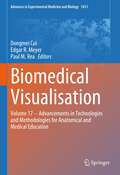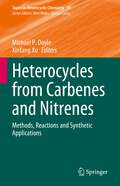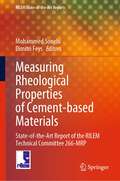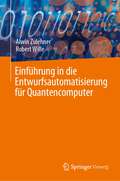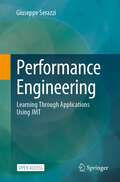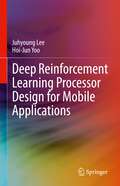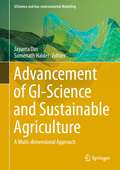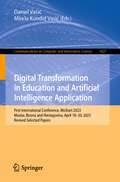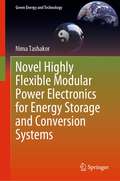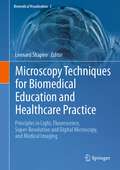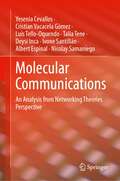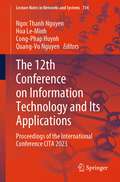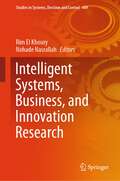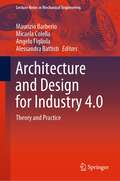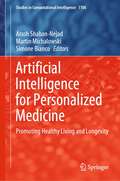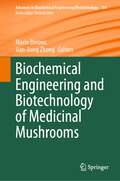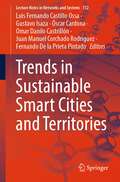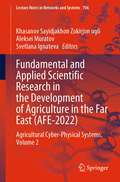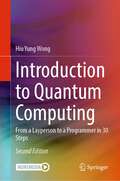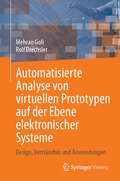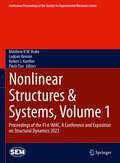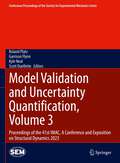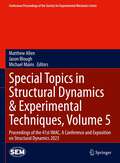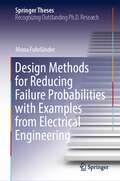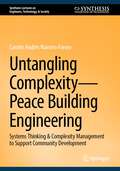- Table View
- List View
Biomedical Visualisation: Volume 17 ‒ Advancements in Technologies and Methodologies for Anatomical and Medical Education (Advances in Experimental Medicine and Biology #1431)
by Dongmei Cui Edgar R. Meyer Paul M. ReaCurricula in the health sciences have undergone significant change and reform in recent years. The time allocated to anatomical education in medical, osteopathic medical, and other health professional programs has largely decreased. As a result, educators are seeking effective teaching tools and useful technology in their classroom learning.This edited book explores advances in anatomical sciences education, such as teaching methods, integration of systems-based components, course design and implementation, assessments, effective learning strategies in and outside the learning environment, and novel approaches to active learning in and outside the laboratory and classroom. Many of these advances involve computer-based technologies. These technologies include virtual reality, augmented reality, mixed reality, digital dissection tables, digital anatomy apps, three-dimensional (3D) printed models, imaging and 3D reconstruction, virtual microscopy, online teaching platforms, table computers and video recording devices, software programs, and other innovations. Any of these devices and modalities can be used to develop large-class practical guides, small-group tutorials, peer teaching and assessment sessions, and various products and pathways for guided and self-directed learning. The reader will be able to explore useful information pertaining to a variety of topics incorporating these advances in anatomical sciences education. The book will begin with the exploration of a novel approach to teaching dissection-based anatomy in the context of organ systems and functional compartments, and it will continue with topics ranging from teaching methods and instructional strategies to developing content and guides for selecting effective visualization technologies, especially in lieu of the recent and residual effects of the COVID-19 pandemic. Overall, the book covers several anatomical disciplines, including microscopic anatomy/histology, developmental anatomy/embryology, gross anatomy, neuroanatomy, radiological imaging, and integrations of clinical correlations.
Heterocycles from Carbenes and Nitrenes: Methods, Reactions and Synthetic Applications (Topics in Heterocyclic Chemistry #59)
by Michael P. Doyle Xinfang XuThis book provides researchers in the fields of organic chemistry, organometallic chemistry and homogeneous catalysis with an overview of recent developments in the applications of reactions involving carbene and nitrene intermediates directed to the synthesis of heterocyclic compounds. Multiple pathways through which diverse heterocyclic compounds are accessed occur from a variety of carbene and nitrene precursors through C-H/X-H insertions, cycloadditions, ylide transformations, rearrangements, and cascade reactions. Catalytic processes that form metallo-carbenes and nitrenes offer unparalleled chemo-, regio-, and stereo-selectivities. Insights are provided into the scope of these methodologies and the inherent control of catalyst ligands on reaction selectivities.
Measuring Rheological Properties of Cement-based Materials: State-of-the-Art Report of the RILEM Technical Committee 266-MRP (RILEM State-of-the-Art Reports #39)
by Mohammed Sonebi Dimitri FeysThis book presents the work of the RILEM TC 266-MRP, whose purpose was to enhance the reliability of rheological measurements performed on cement-based materials. It makes users more aware of potential sources of errors in the measurements, and provide guidelines on how to observe, counteract or eliminate the errors. Improving the reliability of rheological measurements will further enhance the use of rheology to investigate different aspects of the fresh properties of cement-based materials. After an introduction into mix design and applications, the book delivers a comprehensive overview of rheology definitions, behavior, and parameters; rheometers; measuring and analysis procedures; difficulties and challenges during measurements; relationships with specific empirical tests; and the behavior of concrete near a surface. This report on the measurement of rheological properties of complex materials such as concrete enables readers to understand the applicable concepts of rheology, and address the challenges on the measuring procedures, the rheological models and some errors and limitations of rheometers used.
Einführung in die Entwurfsautomatisierung für Quantencomputer
by Alwin Zulehner Robert WilleDieses Buch bietet dem Leser einen einfachen Einstieg in das Quantencomputing sowie in den Entwurf entsprechender Geräte. Die Autoren behandeln verschiedene Entwurfsaufgaben, die für das Quantencomputing wichtig sind, und stellen entsprechende Lösungen vor. Eine Besonderheit des Buches ist, dass diese Aufgaben und Lösungen explizit aus der Perspektive der Entwurfsautomatisierung diskutiert werden, d.h. unter Verwendung von cleveren Algorithmen und Datenstrukturen, die von der Entwurfsautomatisierungs-Community für konventionelle Logik (d.h. für elektronische Geräte und Systeme) entwickelt worden sind und nun für diese neue Technologie angewendet werden. Auf diese Weise können relevante Entwurfsaufgaben wesentlich effizienter als bisher durchgeführt werden, was zu Verbesserungen um mehrere Größenordnungen führt (in Bezug auf die Laufzeit und andere Entwurfsziele). Beschreibt den aktuellen Stand der Technik für den Entwurf von Quantenschaltungen, für deren Simulation und für deren Abbildung auf reale Hardware; Bietet eine erste umfassende Einführung in die Entwurfsautomatisierung für Quantencomputer, die sich mit praxisrelevanten Aufgabenstellungen befasst; Es richtet sich sowohl an die Quantencomputer-Gemeinschaft als auch an die Gemeinschaft der Entwurfsautomatisierung und zeigt, welche beeindruckenden Verbesserungen möglich sind, wenn man das Wissen beider Gemeinschaften kombiniert.
Performance Engineering: Learning Through Applications Using JMT
by Giuseppe SerazziThis open access book improves the users' skills needed to implement models for performance evaluation of digital infrastructures. Building a model is usually a relatively easy task, but making it an accurate representation of the phenomenon to be reproduced is a completely different matter. It is well-known that to increase the ability to build reliable models it is necessary to accumulate experience. The book addresses this need by presenting a collection of case studies of increasing complexity. Readers are introduced to the modeling process gradually, learning the basic concepts step-by-step as they go through the case studies. Queueing Networks are used to design the models solved with simulation and analytical techniques from the open source Java Modelling Tools (JMT). Among the models analyzed there are systems for optimizing performance, identifying bottlenecks, evaluating the impact of the variability of traffic and service demands, analyzing the effects of synchronization policies in parallel computing. Four case studies derived from real-life scenarios are also presented: a surveillance system, autoscaling load fluctuations, web app workflow simulation, and crowd computing platform. This book serves as a reference tool for graduate and senior-level computer science students in courses of performance evaluation and modeling, as well as for researchers and practitioners.
Deep Reinforcement Learning Processor Design for Mobile Applications
by Juhyoung Lee Hoi-Jun YooThis book discusses the acceleration of deep reinforcement learning (DRL), which may be the next step in the burst success of artificial intelligence (AI). The authors address acceleration systems which enable DRL on area-limited & battery-limited mobile devices. Methods are described that enable DRL optimization at the algorithm-, architecture-, and circuit-levels of abstraction.
Advancement of GI-Science and Sustainable Agriculture: A Multi-dimensional Approach (GIScience and Geo-environmental Modelling)
by Jayanta Das Somenath HalderThis book describes the contributing aspects of contemporary developments related to sustainable agricultural resources and assessment of sustainable agriculture in developing nations. The issues like food crisis and declining agro-productivity, post-pandemic food security, zonation and mapping technique viewing food crisis, biotechnology and sustainable agricultural, scaling hunger indices, health hazard and food crisis, changing climate and food availability, consumer load and fertilizer usage, growing demand and increasing usage of harmful chemical in agro-fields are regarded as serious concerns. Thereafter, the scope of sustainable agricultural potentiality (SAP) modeling, amidst the arena of deforestation and encroachment of new cultivable land, impact of pandemic on sustainable agriculture, using wastewater as non-sustainable agricultural practice, applying geospatial techniques on extreme weather susceptibility and agro-production, soil erosion and poor agricultural production, questioning shifting cultivation on the issue of sustainability, meteorological drought and irrigational gaps, occupational mobility and loss of agricultural heritage, farm-excreta burning and air quality index (AQI), GI-Science and sustainable agro-management, community preparedness in food crisis management, multi-criteria hunger index (MCHI), climate change declining sustainable agro-production are worth some. Almost the entire world has recently suffered from several natural and human-induced problems, among which food crisis and unsustainable agriculture throw significant challenges to human society. Contrastingly, if modern technology and means, with advanced monitoring and calibration methodology and policy guidance, can help, it will undoubtedly reduce half of the world's problems and ensure the future survival of human society. In addition, this approach also can minimize the other partially linked problems, like climate change and food shortage, livelihood crisis, environmental refugees, international trade balance, global food supply chain interruption, the ever-expanding gap between rich and poor, and so on. Therefore, properly nurturing the knowledge on the application of GI-Science for an agriculturally sustainable society and their monitoring and management can curtail the gap between science, policy, and the ground-level scenario concerned.
Digital Transformation in Education and Artificial Intelligence Application: First International Conference, MoStart 2023, Mostar, Bosnia and Herzegovina, April 18–20, 2023, Revised Selected Papers (Communications in Computer and Information Science #1827)
by Daniel Vasić Mirela Kundid VasićThis book constitutes selected papers presented during the First International Conference on Digitization in Education, MoStart 2023, held in Mostar, Bosnia and Herzegovina, in April 2023.The 12 presented papers were thoroughly reviewed and selected from the 30 submissions. The proceedings cover a diverse range of topics, including artificial intelligence and robotics in education, games and simulations, intelligent tutoring systems, augmented and virtual reality, natural language processing, computer vision, IoT and metaverse applications, learning analytics, deep learning, and ethical issues in AI applications in education and law.
Novel Highly Flexible Modular Power Electronics for Energy Storage and Conversion Systems (Green Energy and Technology)
by Nima TashakorThis book describes improvements to the electronics topology of current modular reconfigurable storages by integrating parallel connectivity, reducing the semiconductor count by eliminating irrelevant states, and improving the monitoring techniques through higher function integration. The author also discusses each topology's main advantages and disadvantages at the micro and macro levels. Moreover, the presented modeling of modular reconfigurable storage systems with different storages helps in better understanding the dynamics of the system.The book establishes novel optimum or near-optimum methods for exploiting the DOF (degrees of freedom) to achieve higher efficiency, more function integration, better balancing, or output quality. Additionally, through a detailed analysis of different modulation techniques, this book presents novel modulation methods, enhances the state-of-the-art, or in some cases, simplifies the complexity of implementation.The concept of interconnected multi-port systems through integrating novel modulation techniques and the acquired understanding of the behavior of modular dynamically reconfigurable storages is explained. The presented concepts can significantly reduce the number of energy conversion stages as well as the final footprint of the system, reduce the number of required controlled semiconductors, and save costs. It also presents novel monitoring techniques based on estimators that can significantly reduce the number of required sensors and the required data-communication bandwidth.
Microscopy Techniques for Biomedical Education and Healthcare Practice: Principles in Light, Fluorescence, Super-Resolution and Digital Microscopy, and Medical Imaging (Biomedical Visualization #2)
by Leonard ShapiroThis edited book has a strong focus on advances in microscopy that straddles research, medical education and clinical practice. These advances include the shift in power from conventional to digital microscopy. The first section of this book covers imaging techniques and morphometric image analysis with its applications in biomedicine using different microscopy modes. Chapters highlight the rich development of fluorescence methods and technologies; particle tracking techniques with applications in biomedical research and nanomedicine; the way in which visualizations have revolutionized taxonomy from gross anatomy to genetics; and the psychology of perception and how it affects our understanding of cells and tissues. The book’s first section concludes by exploring the use of CT modalities to evaluate anterior deformities in craniosynostosis. In the second section of the book, chapters on anatomical and cell biology education explore the history of anatomical models and their use in educational settings. This includes examples in 3D printing and functional human anatomical models that can be created using easily available resources and the use of biomedical imaging in visuospatial teaching of anatomy; the novel use of ultrasound in medical education and practice; and skill acquisition in histology education using a flowchart called a ‘decision tree’. This book will appeal to histologists, microscopists, cell biologists, clinicians and those involved in anatomical education and biomedical visualization, as well as students in those respective fields.
Molecular Communications: An Analysis from Networking Theories Perspective
by Yesenia Cevallos Cristian Vacacela Gómez Luis Tello-Oquendo Talia Tene Deysi Inca Ivone Santillán Albert Espinal Nicolay SamaniegoThis book provides a complete analysis of molecular communications systems from the paradigm of TCP/IP network stack, and it exploits network theories (e.g. independent functions of a layer into a stack, addressing, flow control, error control, and traffic control) and applies them to biological systems. The authors show how these models can be applied in different areas such as industry, medicine, engineering, biochemistry, biotechnology, computer sciences, and other disciplines. The authors then explain how it is possible to obtain enormous benefits from these practices when applied in medicine, such as enhancing current treatment of diseases and reducing the side effects of drugs and improving the quality of treatment for patients. The authors show how molecular communications systems, in contrast to existing telecommunication paradigms, use molecules as information carriers. They show how sender biological nanomachines (bio-nano machines) encode data on molecules (signal molecules) and release the molecules into the environment. They go on to explain how the molecules then travel through the environment to reach the receiver bio-nano machines, where they biochemically react with the molecules to decipher information. This book is relevant to those studying telecommunications and biomedical students, engineers, masters, PhDs, and researchers.
The 12th Conference on Information Technology and Its Applications: Proceedings of the International Conference CITA 2023 (Lecture Notes in Networks and Systems #734)
by Ngoc Thanh Nguyen Hoa Le-Minh Cong-Phap Huynh Quang-Vu NguyenThis book constitutes the refereed proceedings of the 12th Conference on Information Technology and its Applications, CITA 2023, taking place on July 28-29, 2023 in Da Nang City, the most beautiful and livable city in Vietnam. CITA is an annual scientific conference on information technology and its applications in all fields. The main objective of the conference is to create a forum to gather and connect Vietnamese and international researchers, scientists in the fields of information technology and its applications. The book includes 33 papers, selected from 144 papers submitted to CITA 2023 whose authors come from over 20 countries around the world, which were carefully reviewed by at least two members of the Program Committee, with professional advice from reputable scientists in the field of information technology and technology, digital economy such as Prof. Dr.Sc. Ngoc-Thanh Nguyen (Poland), Prof. Dr. Dosam Hwang (Korea), Assoc. Prof. Dr. Le Minh Hoa (UK), and Prof.Dr. Nguyen Thanh Thuy (Vietnam). The acceptance rate of CITA 2023 is about 24%. The papers in the book are organized in the following topical sections: Data Science and Artificial Intelligence; Image and Natural Language Processing; Software Engineering and Information Systems; Network and Communications; and Digital Economy. The accepted and presented papers focus on new trends and challenges facing the information and communication technology as well as digital economy community. If you are scientists, lecturers, doctoral students, we hope that you will find many useful and good quality results from the book for your future research.
Intelligent Systems, Business, and Innovation Research (Studies in Systems, Decision and Control #489)
by Rim El Khoury Nohade NasrallahIntelligent systems research is a multidisciplinary field that focuses on the development of systems that can perceive, reason, and act autonomously. This can include areas such as machine learning, artificial intelligence, natural language processing, and robotics. The goal of intelligent systems research is to develop systems that can understand, learn from, and adapt to their environment, to perform tasks that would typically require human intelligence.Business and innovation research is an interdisciplinary field that examines how organizations can create, develop, and implement new ideas, products, and services. This can include areas such as organizational behaviour, strategic management, and marketing. The goal of business and innovation research is to understand how organizations can foster an environment that encourages creativity and innovation, and how they can develop and implement new ideas in a way that leads to success.Intelligent Systems, Business and Innovation Research is a research area that brings together these two fields to study the use of intelligent systems and technologies in the business context to drive innovation, improve operational efficiency and effectiveness of the organization. The book aims to understand how intelligent systems can be used in business applications, how to design and implement them, how to manage the associated challenges, and how to leverage them to foster innovation, create new business models, and gain competitive advantage. It offers guidance on how to navigate potential conflicts and challenges that may arise during multidisciplinary research in areas such as Industry 4.0, Internet of Things, modern machine learning, software agent applications, and data science. The book focuses on the various fields in which intelligent systems play a critical role in enabling the development of advanced technologies that can perform tasks that would typically require human intelligence. For example, in smart/control systems, intelligent algorithms can be used to optimize the performance of machines and devices, while in cyber security, they can be used to protect networks and data from cyber-attacks. In bioinformatics, intelligent systems can be used to analyse large amounts of biological data, while in virtual reality and robotics, they can be used to create realistic and responsive simulations and automatons. Additionally, the book also highlights the rapidly advancing theoretical foundations of fuzzy sets, mathematical logic, and non-classical logic. These are important theoretical frameworks for the development of intelligent systems, as they provide the foundation for the representation and manipulation of uncertainty, complexity, and imprecision. These theoretical foundations are essential in the development of intelligent systems that can make decisions and perform tasks in uncertain, complex, and dynamic environments.
Architecture and Design for Industry 4.0: Theory and Practice (Lecture Notes in Mechanical Engineering)
by Maurizio Barberio Micaela Colella Angelo Figliola Alessandra BattistiThis book collects contributions of forefront research and practices related to the use of the enabling technologies of Industry 4.0 in the architecture and design fields and their impact on the UN's Sustainable Developments goals. The book is structured into three sections (research, practice, and technologies), with the goal of creating a new framework useful for widespread awareness necessary to initiate technology transfer processes for the benefit of the public sector, universities, research centers, and innovative companies, and a new professional figure capable of controlling the entire process is essential. Thus, the book chapters arouse a series of relevant topics such as computational and parametric design, performance-based architecture, data-driven design strategies, parametric environmental design and analysis, computational and parametric structural design and analysis, AI and machine learning, BIM and interoperability, VR and AR, digital and robotic fabrication, additive manufacturing and 3D printing, R&D and entrepreneurship, circular architecture, and didactics. In the post-digital era, where the essence of design lies in the control and information of the process that holistically involves all the aspects mentioned above, rather than in formal research, it is necessary to understand technologies and analyze the advantages that they can bring in terms of environmental sustainability and product innovation.
Artificial Intelligence for Personalized Medicine: Promoting Healthy Living and Longevity (Studies in Computational Intelligence #1106)
by Arash Shaban-Nejad Martin Michalowski Simone BiancoThis book aims to highlight the latest achievements in the use of AI in personalized medicine and healthcare delivery. The edited book contains selected papers presented at the 2023 Health Intelligence workshop, co-located with the Thirty-Seven Association for the Advancement of Artificial Intelligence (AAAI) conference, and presents an overview of the issues, challenges, and potentials in the field, along with new research results. This book provides information for researchers, students, industry professionals, clinicians, and public health agencies interested in the applications of AI in medicine and public health.
Biochemical Engineering and Biotechnology of Medicinal Mushrooms (Advances in Biochemical Engineering/Biotechnology #184)
by Marin Berovic Jian-Jiang ZhongThis book offers a comprehensive review of the latest developments in medicinal mushroom biochemical engineering and biotechnology, and it also analyses the circular economy of mushroom bioproduction. Divided into 13 chapters, the book begins with a historical perspective of medicinal mushrooms, followed by authoritative chapters that explore the farming of medicinal mushrooms and bioeconomy, as well as the limitations of using medicinal mushrooms to produce metabolites. Subsequent chapters cover topics such as solid-state and submerged cultivation of medicinal mushroom mycelia in bioreactors, pilot and industrial bioreactor cultivation experiences, downstream processing of medicinal mushroom products, and biochemistry of medicinal mushroom bioactive compounds. Particular attention is given to the recent genetic engineering techniques applied in mushroom cultivation. The book closes with a chapter devoted to the health and clinical benefits of medicinal fungi, where readers will find expert insights into the therapeutic implications of medicinal fungi. In this book, readers will find an authoritative perspective on the past, present and future of medicinal mushrooms, and will also learn about some recent clinical studies with isolates from these natural products. Given its breadth, this book will appeal to biotechnologists working in mushroom cultivation, as well as to professionals interested in traditional pharmacy and medicine.
Trends in Sustainable Smart Cities and Territories (Lecture Notes in Networks and Systems #732)
by Luis Fernando Castillo Ossa Gustavo Isaza Óscar Cardona Omar Danilo Castrillón Juan Manuel Corchado Rodriguez Fernando De la Prieta PintadoThis book presents the latest scientific and technical advances in the fields of Smart Cities and Smart Territories. It shows outcomes of 2nd Sustainable Smart Cities and Territories International Conference in Manizales (Colombia) on June 21–23, 2023. The concept of smart cities, which emerged in the early 2000s, attempts to solve these challenges by implementing information and communication technologies. The initial concept of smart cities focused on the modernization of megacities.
Fundamental and Applied Scientific Research in the Development of Agriculture in the Far East: Agricultural Cyber-Physical Systems, Volume 2 (Lecture Notes in Networks and Systems #706)
by Khasanov Sayidjakhon Zokirjon ugli Aleksei Muratov Svetlana IgnatevaThe book presents a collection of scientific research in the field of agriculture cyber-physical systems (ACPSs). The methods and tools for agricultural systems design, estimation and monitoring are proposed in this book. The book presents technical developments in the robotics and IoT sector, new solutions with drones, sensors and smart agriculture machines, solutions to digitize the farmer's life by delivering holistic management platforms and monitoring systems, as well as studies devoted to the field mapping. Research on creating a digital twin of the supply chain to predict the near-future state of the supply chain are also presented in this book. The book contains proceedings of the conference "Fundamental and Applied Scientific Research in the Development of Agriculture in the Far East" (AFE-2022, Tashkent, Uzbekistan). The book allows optimizing agricultural production, maximizes their yield and minimizes losses with efficient use of resources and decreases skilled labor.
Introduction to Quantum Computing: From a Layperson to a Programmer in 30 Steps
by Hiu Yung WongThis textbook introduces quantum computing to readers who do not have much background in linear algebra based on the self-study experience of the author as an engineer. The author targets undergraduate and master students who are willing to spend about 60 -90 hours seriously learning quantum computing. This book is also suitable for self-study and teaching videos for each chapter and more than 200 exercises with answers are provided. Readers will be able to write their program to simulate quantum computing algorithms and run on real quantum computers on IBM-Q. Moreover, unlike books that only give superficial, “hand-waving” explanations, this book uses exact formalism so readers can continue to pursue more advanced topics based on what they learn from this book
Automatisierte Analyse von virtuellen Prototypen auf der Ebene elektronischer Systeme: Design, Verständnis und Anwendungen
by Mehran Goli Rolf DrechslerDieses Buch beschreibt eine Reihe von SystemC-basierten Analysemethoden für virtuelle Prototypen, einschließlich Entwurfsverständnis, Verifikation, Sicherheitsvalidierung und Entwurfsraumuntersuchung. Der Leser erhält einen Überblick über die neuesten Forschungsergebnisse auf dem Gebiet der Electronic Design Automation (EDA) auf der elektronischen Systemebene (ESL). Die besprochenen Methoden ermöglichen es den Lesern, wichtige Aufgaben und Anwendungen im Entwurfsprozess leicht zu bewältigen.Übersetzt mit www.DeepL.com/Translator (kostenlose Version)
Nonlinear Structures & Systems, Volume 1: Proceedings of the 41st IMAC, A Conference and Exposition on Structural Dynamics 2023 (Conference Proceedings of the Society for Experimental Mechanics Series)
by Matthew R. W. Brake Ludovic Renson Robert J. Kuether Paolo TisoNonlinear Structures & Systems, Volume 1: Proceedings of the 41st IMAC, A Conference and Exposition on Structural Dynamics, 2023, the first volume of ten from the Conference brings together contributions to this important area of research and engineering. The collection presents early findings and case studies on fundamental and applied aspects of Nonlinear Dynamics, including papers on:Experimental Nonlinear DynamicsJointed Structures: Identification, Mechanics, DynamicsNonlinear DampingNonlinear Modeling and SimulationNonlinear Reduced-Order ModelingNonlinearity and System Identification
Model Validation and Uncertainty Quantification, Volume 3: Proceedings of the 41st IMAC, A Conference and Exposition on Structural Dynamics 2023 (Conference Proceedings of the Society for Experimental Mechanics Series)
by Roland Platz Garrison Flynn Kyle Neal Scott OuelletteModel Validation and Uncertainty Quantification, Volume 3: Proceedings of the 41st IMAC, A Conference and Exposition on Structural Dynamics, 2023, the third volume of ten from the Conference brings together contributions to this important area of research and engineering. The collection presents early findings and case studies on fundamental and applied aspects of Model Validation and Uncertainty Quantification, including papers on:Introduction of Uncertainty QuantificationUncertainty Quantification in DynamicsModel Form Uncertainty and Selection incl. Round Robin ChallengeSensor and Information FusionVirtual Sensing, Certification, and Real-Time MonitoringSurrogate Modeling
Special Topics in Structural Dynamics & Experimental Techniques, Volume 5: Proceedings of the 41st IMAC, A Conference and Exposition on Structural Dynamics 2023 (Conference Proceedings of the Society for Experimental Mechanics Series)
by Matthew Allen Jason Blough Michael MainsSpecial Topics in Structural Dynamics & Experimental Techniques, Volume 5: Proceedings of the 41st IMAC, A Conference and Exposition on Structural Dynamics, 2023, the fifth volume of ten from the Conference brings together contributions to this important area of research and engineering. The collection presents early findings and case studies on fundamental and applied aspects of Structural Dynamics, including papers on:Active ControlAdditive ManufacturingExperimental TechniquesFinite Element TechniquesMultifunction StructuresRotating MachinerySystem Identification
Design Methods for Reducing Failure Probabilities with Examples from Electrical Engineering (Springer Theses)
by Mona FuhrländerThis book deals with efficient estimation and optimization methods to improve the design of electrotechnical devices under uncertainty. Uncertainties caused by manufacturing imperfections, natural material variations, or unpredictable environmental influences, may lead, in turn, to deviations in operation. This book describes two novel methods for yield (or failure probability) estimation. Both are hybrid methods that combine the accuracy of Monte Carlo with the efficiency of surrogate models. The SC-Hybrid approach uses stochastic collocation and adjoint error indicators. The non-intrusive GPR-Hybrid approach consists of a Gaussian process regression that allows surrogate model updates on the fly. Furthermore, the book proposes an adaptive Newton-Monte-Carlo (Newton-MC) method for efficient yield optimization. In turn, to solve optimization problems with mixed gradient information, two novel Hermite-type optimization methods are described. All the proposed methods have been numerically evaluated on two benchmark problems, such as a rectangular waveguide and a permanent magnet synchronous machine. Results showed that the new methods can significantly reduce the computational effort of yield estimation, and of single- and multi-objective yield optimization under uncertainty. All in all, this book presents novel strategies for quantification of uncertainty and optimization under uncertainty, with practical details to improve the design of electrotechnical devices, yet the methods can be used for any design process affected by uncertainties.
Untangling Complexity—Peace Building Engineering: Systems Thinking & Complexity Management to Support Community Development (Synthesis Lectures on Engineers, Technology, & Society #29)
by Camilo Andrés Navarro ForeroThis book examines how the rapid acceleration and interconnection of globalization comes with the need for more flexible and adaptable solutions to complex problems and solutions. It describes and demonstrates possible combinations of methods and methodologies to address the complex problems that the world offers us today. Sharing meaningful experiences of the application of workshops in mixed public private companies and with vulnerable communities and peacebuilding communities. The text offers readers, who are looking for tools to face complexity and enhance their projects, real-world examples and accessible methods. The book is based on advanced engineering tools however it is understandable and accessible to a broad audience.This book is for decision makers involved with social complex systems who are uncertain about how they should start and proceed. Discussions on new methodologies to support engineering interventions with communities are being shown. A new multi-methodology proposal called “Complexity Funnel Methodology” (CFM) dissected in “Social Transformation Workshops” (STW) is provided and discussed. It is used with combinations of different methods and methodologies of critical Systems thinking. The implementation of this methodology is described using a case study approach.
